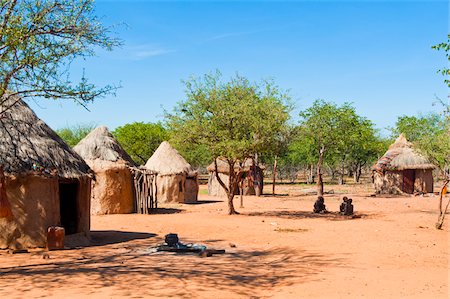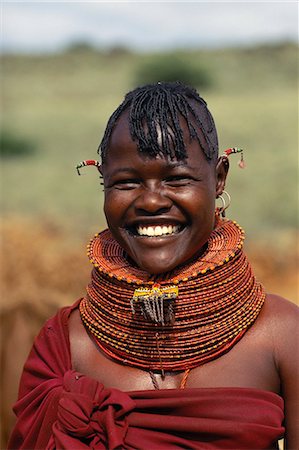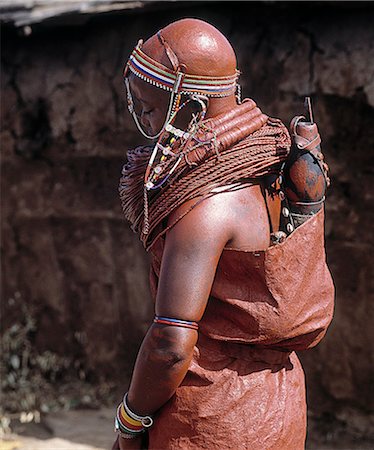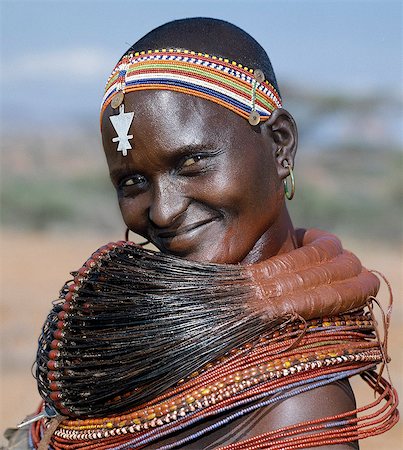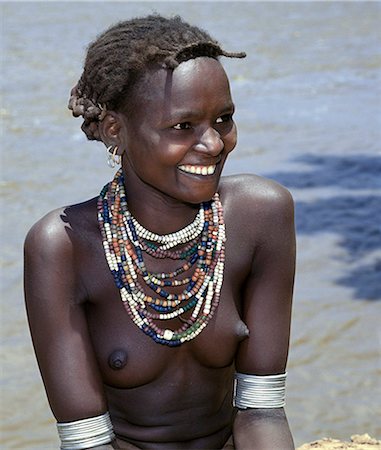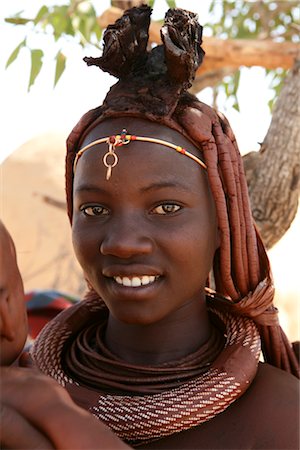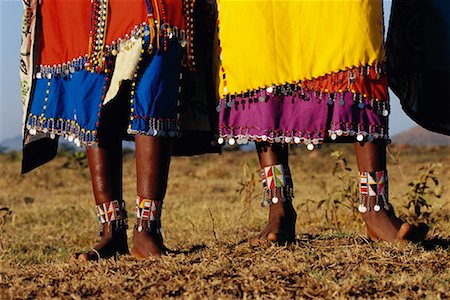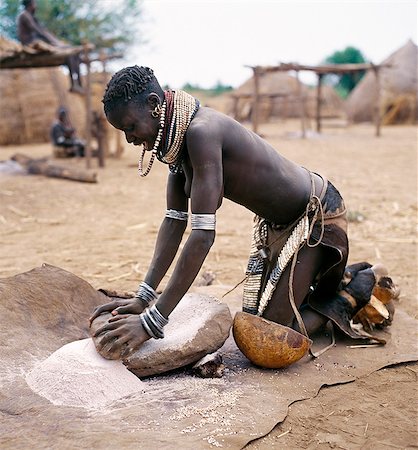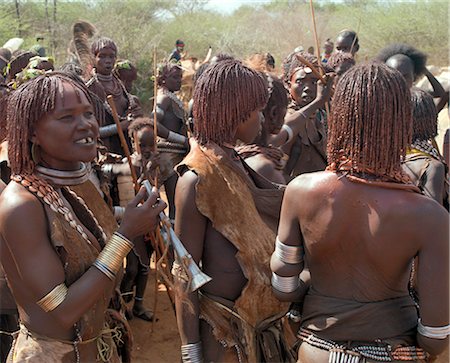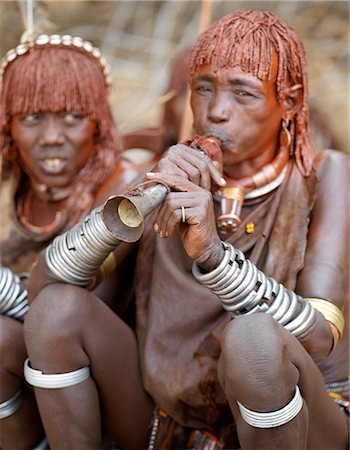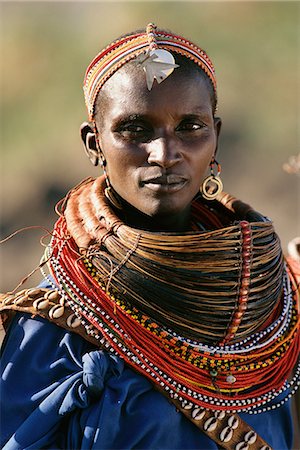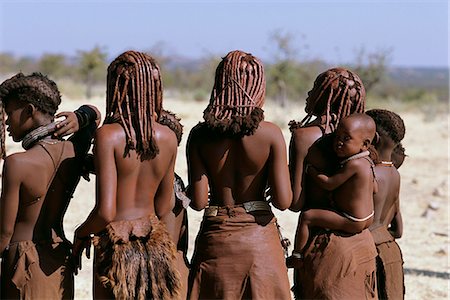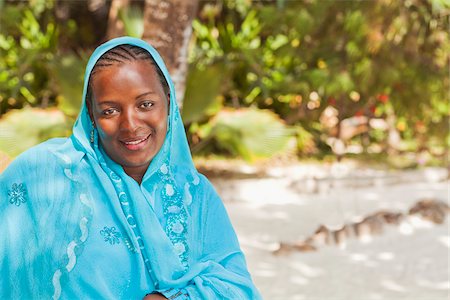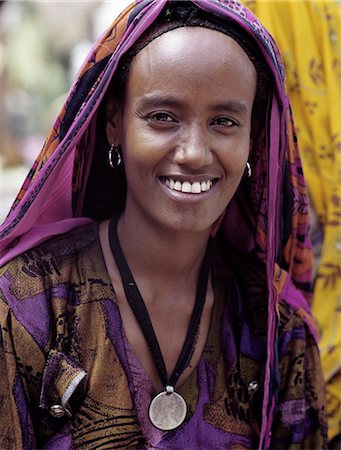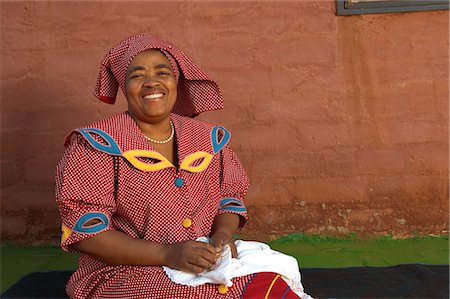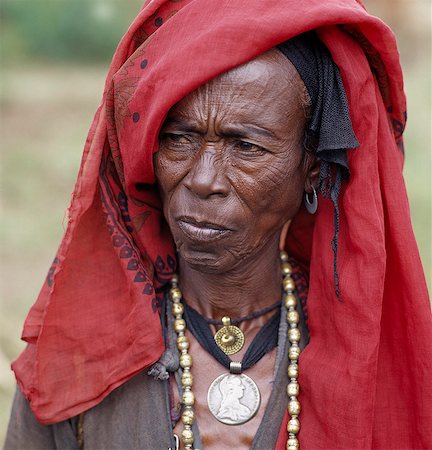-
Red Ochre (or ocher stone) pigment used by Himba to create a reddish tint, Kaokoveld, Namibia, Africa
Rights-Managed
-
Himba woman making butter in a dried pumpkin, Kaokoveld, Namibia, Africa
Rights-Managed
-
Portrait of Himba woman, showing hairstyle of Himba women, Kaokoveld, Namibia, Africa
Rights-Managed
-
Close-up of woman's legs and feet, sitting on decorated round henhouse with eggs, Tiebele, Burkina Faso
Rights-Managed
-
An old Dassanech woman prepares her fields beside the Omo River with a digging stick in readiness to plant sorghum. This crude form of agricultural implement is in common use in this remote part of Ethiopia.
Rights-Managed
-
A Nyangatom woman wears multiple layers of beads in necklaces, an elaborately beaded calfskin skirt and metal bracelets, amulets and anklets. She is standing beside a temporary beehive construction of sticks, grass and leaves built to provide shade for her goats. The Nyangatom or Bume are a Nilotic tribe of semi-nomadic pastoralists who live along the banks of the Omo River in south western Ethio
Rights-Managed
-
A Samburu bride waits pensively outside her new home until she is enticed in with promises of cattle.Her wedding gown is made of three goatskins, which are well oiled and covered in red ochre.She carries on her back a gourd full of milk and a small wooden jar containing butter.She now wears the mporro necklace of married women.
Rights-Managed
-
A Samburu woman wearing a mporro necklace, which denotes her married status. These necklaces were once made of hair from giraffe tails but nowadays, the fibres of doum palm fronds, Hyphaene coriacea, are used instead.The red beads after which the necklace is named are wound glass beads made in Venice c.1850.
Rights-Managed
-
A Samburu woman wearing a mporro necklace, which denotes her married status. These necklaces were once made of hair from giraffe tails but nowadays, the fibres of doum palm fronds, Hyphaene coriacea, are used instead.The red beads after which the necklace is named are wound glass beads made in Venice c.1850.
Rights-Managed
-
A Samburu woman wearing a mporro necklace, which denotes her married status. These necklaces were once made of hair from giraffe tails but nowadays, the fibres of doum palm fronds, Hyphaene coriacea, are used instead.The red beads after which the necklace is named are wound glass beads made in Venice c.1850.
Rights-Managed
-
A Karo woman with her face painted in preparation for a dance in the village of Duss. A small Omotic tribe related to the Hamar, who live along the banks of the Omo River in southwestern Ethiopia, the Karo are renowned for their elaborate body painting using white chalk, crushed rock and other natural pigments. She is wearing a goatskin apron and carries a leather belt decorated with cowrie shells
Rights-Managed
-
A Karo women stands in the doorway to her hut in the village of Duss. A small Omotic tribe related to the Hamar, who live along the banks of the Omo River in southwestern Ethiopia, the Karo are renowned for their elaborate body painting using white chalk, crushed rock and other natural pigments. In addition to painting her face she has decorated her body with whorls of goat hair tied by leather co
Rights-Managed
-
A Mursi girl, accompanied by her dog, carries a large clay pot to collect water from the Omo River. Her earlobes are already pierced and extended, and decorated with round clay discs.She is dressed in skins, attractively decorated with thin stripes.The culture, social organisation, customs and values of the people have changed little.
Rights-Managed
-
A Mursi woman wearing a large clay lip plate. Shortly before marriage, a girls lower lip will be pierced and progressively stretched over a year or so. The size of the lip plate often determines the quantum of the bride price. They live in a remote area of southwest Ethiopia along the Omo River, the country's largest river.
Rights-Managed
-
A Mursi woman wearing a large wooden lip plate. Shortly before marriage, a girls lower lip will be pierced and progressively stretched over a year or so. The size of the lip plate often determines the quantum of the bride price. They live in a remote area of southwest Ethiopia along the Omo River.
Rights-Managed
-
Shaded from the hot sun, a Karo woman grinds sorghum using large flat stones.It is customary for females of the tribe when in their teens to make a small hole in the flesh below their lower lips into which they put an ornament, this woman has used a small nail. Numerous heavy metal bracelets are worn by married womenThe Karo are a small tribe living in three main villages along the lower reaches o
Rights-Managed
-
A young Daasanech girl beside the Omo River. Her hairstyle, necklaces and metal armbands are typical of her tribe.The Dassanech people live in the Omo Delta of southwest Ethiopia, one of the largest inland deltas in the world.
Rights-Managed
-
A Samburu Warrior drives his goats along the wide,sandy seasonal watercourse of the Milgis where waterholes dug by the Samburu in the dry season are a lifeline for pastoralists in this semi-arid region of their district.
Rights-Managed
-
Samburu girls are given strings of beads by their fathers when they are still young. As soon as they are old enough to have lovers from the warrior age set, they regularly receive gifts from them.Over a period of years, their necklaces can smother them up to their necks.
Rights-Managed
-
A Nyangatom woman grinds sorghum using a flat stone.The Nyangatom are one of the largest tribes and arguably the most warlike people living along the Omo River in Southwest Ethiopia.They form a part of the Ateger speaking people a cluster of seven eastern Nilotic tribes to which the Turkana of Northern Kenya and the Karamajong of Eastern Uganda belong.
Rights-Managed
-
A Nyangatom woman dries sorghum and other corn in the vicinity of her elevated grain stores, which prevent loss when the Omo River bursts its banks.The Nyangatom are one of the largest tribes and arguably the most warlike people living along the Omo River in Southwest Ethiopia.
Rights-Managed
-
A pregnant Nyangatom woman in traditional attire outside her neatly thatched home.The Nyangatom are one of the largest tribes and arguably the most warlike people living along the Omo River in Southwest Ethiopia.
Rights-Managed
-
A Hamar woman dances around cattle while she blows a tin trumpet at a Jumping of the Bull ceremony.The Hamar are semi nomadic pastoralists of Southwest Ethiopia whose women wear striking traditional dress and style their red ochred hair mop fashion.The Jumping of the Bull ceremony is a rite of passage for young men.
Rights-Managed
-
Hamar women dance at a Jumping of the Bull ceremony.The Hamar are semi nomadic pastoralists of Southwest Ethiopia whose women wear striking traditional dress and style their red ochred hair mop fashion. The Jumping of the Bull ceremony is a rite of passage for young men.After the ceremony, the initiate attains full manhood and is permitted to marry.
Rights-Managed
-
Hamar women dance around cattle at a Jumping of the Bull ceremony as a rainbow gives colour to a threatening sky overhead.The Hamar are semi nomadic pastoralists of Southwest Ethiopia whose women wear striking traditional dress and style their red ochre hair mop fashion.The phallic protrusion of the women's chokers denote they are their husbands first wives.The Jumping of the Bull ceremony is a ri
Rights-Managed
-
A group of Hamar women at a Jumping of the Bull ceremony.The Hamar are semi nomadic pastoralists of Southwest Ethiopia whose women wear striking traditional dress and style their red ochred hair mop fashion.The Jumping of the Bull ceremony is a rite of passage for young men.
Rights-Managed
-
A Hamar woman blows a tin trumpet at a Jumping of the Bull ceremony.The Hamar are semi nomadic pastoralists of Southwest Ethiopia whose women wear striking traditional dress and style their red ochred hair mop fashion.The Jumping of the Bull ceremony is a rite of passage for young men.
Rights-Managed
-
A Hamar woman blows a tin trumpet at a Jumping of the Bull ceremony.The Hamar are semi nomadic pastoralists of Southwest Ethiopia whose women wear striking traditional dress and style their red ochred hair mop fashion.The Jumping of the Bull ceremony is a rite of passage for young men.
Rights-Managed
-
A Hamar woman at a Jumping of the Bull ceremony.The Hamar are semi nomadic pastoralists of Southwest Ethiopia whose women wear striking traditional dress and style their red ochred hair mop fashion.The Jumping of the Bull ceremony is a rite of passage for young men.
Rights-Managed
-
A Hamar woman blows a tin trumpet at a Jumping of the Bull ceremony.The Hamar are semi nomadic pastoralists of Southwest Ethiopia whose women wear striking traditional dress and style their red ochred hair mop fashion.The Jumping of the Bull ceremony is a rite of passage for young men.
Rights-Managed
-
Portrait of Woman Leaning Against Tree, Zanzibar, United Republic of Tanzania, Africa
Rights-Managed
-
A Dassanech woman milks a cow by hand collecting the milk in a gourd at a settlement alongside the Omo River. Much the largest of the tribes in the Omo Valley numbering around 50,000,the Dassanech (also known as the Galeb,Changila or Merille) are Nilotic pastoralists and agriculturalists.
Rights-Managed
-
Woman Looking at Snapshots, Nyota Beach, Unguja, Zanzibar, Tanzania
Premium Royalty-Free
-
A young Nyangatom woman carries her baby on her hip in an elaborately braided papoose. Her hair has been reddened with a mixture of ochre and animal fat. Typical of her tribe, she wears a calfskin skirt, multiple layers of bead necklaces and metal bracelets and amulets. The Nyangatom or Bume are a Nilotic tribe of semi nomadic pastoralists who live along the banks of the Omo River in south western
Rights-Managed
-
A Nyangatom woman stands with her baby on her hip beside her grass hut in his temporary camp. Nyangatom married women wear elaborately beaded skirts which reach the ground at the back and often have panels of different coloured calkfskin sewn into the tail The Nyangatom or Bume are a Nilotic tribe of semi nomadic pastoralists who live along the banks of the Omo River in south western Ethiopia.
Rights-Managed
-
A woman at Senbete market wears old silver and brass jewellery.Her two pendants are made from Maria Theresa thalers, old silver coins minted in Austria, which were widely used as currency in northern Ethiopia and Arabia until the end of World War II.Other silver coins have been strung on her necklace.
Rights-Managed
-
An Oromo old woman wears a necklace and a pendant made from a Maria Theresa thaler, an old silver coin minted in Austria, which was widely used as currency in northern Ethiopia and Arabia until the end of World War II. She was on her way to Senbete, an important weekly market close to the western scarp of the Abyssinian Rift.Afar nomads from the low lying arid regions of Eastern Ethiopia trek long
Rights-Managed
-
A woman in a colourful dress and matching headscarf wears round her neck a Maria Theresa thaler an old silver coin minted in Austria, which was widely used as currency in northern Ethiopia and Arabia until the end of World War II.
Rights-Managed
-
Woman in Traditional Clothing in Vegetable Garden, Vosloorus, Gauteng, South Africa
Rights-Managed
-
Portrait of Woman in Traditional Clothing, Vosloorus, Gauteng, South Africa
Rights-Managed
-
Portrait of Woman in Traditional Clothing, Vosloorus, Gauteng, South Africa
Rights-Managed
-
Low section of woman sitting indoors, showing legs, feet and hands painted with henna in arabic style, wearing a typical black, arabic, muslim dress, studio shot
Premium Royalty-Free
-
Kenya, Samburu District. A Samburu woman, wearing intricate beaded necklaces, leans against her mud hut towards the end of the day.
Rights-Managed
-
A Nyangatom woman milks her familys cows early in the morning. It is the sole responsibility of women and children to milk cows, Nyangatom men will never do so.The Nyangatom are one of the largest tribes and arguably the most warlike people living along the Omo River in Southwest Ethiopia.
Rights-Managed
-
An attractive Oromo girl in the medieval walled city of Harar. Her beaded jewellery sets her apart from Harari residents.Once an independent city state dating back to the early 16th century, Harar was incorporated into the Ethiopian Empire in 1887.
Rights-Managed
-
Ethiopia, Harerge Province, Harar.An Harari girl in wedding attire.Unlike Muslims elsewhere, Harari women love bright clothes and are seen in public without face veils.The beautifully embroidered silk dress can be turned inside out, where it is black, and worn at funerals.
Rights-Managed
-
An old Oromo woman wears a brass necklace and pendant, and a silver pendant made from a Maria Theresa thaler, an old silver coin minted in Austria, which was widely used as currency in northern Ethiopia and Arabia until the end of World War II. With a bright red headscarf, She was on her way to Senbete, an important weekly market close to the western scarp of the Abyssinian Rift.
Rights-Managed
-
Portrait of African Woman Wearing Traditional Clothing, Soweto, Gauteng, South Africa
Rights-Managed
-
A Samburu woman singing. The strings of black and white beads hanging from her ears signify that she has two grown-up sons who are warriors of the tribe. Note: the traditional horn snuff container hanging from her neck.
Rights-Managed






